Using PeopleSoft Fluid User Interface for Expenses
PeopleSoft Fluid User Interface is an alternative user interface to the PeopleSoft Classic User Interface. PeopleSoft Fluid pages are designed to be used on all types of devices such as smart phones, tables, laptops and desktops. When accessing a PeopleSoft fluid page, the system detects the device you are using and renders the appropriate page.
When you log into the system, the PeopleSoft Fluid Employee Self-Service homepage appears. Select the Expenses tile on the Employee Self Service homepage to view the Expenses homepage. From this homepage, you can view notifications and navigate to various PeopleSoft Expenses processes by selecting the individual tiles.
|
Tiles |
Description |
|---|---|
|
View notifications and navigate to various PeopleSoft Expenses processes. |
|
|
Displays messages regarding expense policy notices, changes in travel security, and so on. |
|
|
Select to add transactions directly to My Wallet. |
|
|
Select to review and edit My Wallet transactions. |
|
|
Select to add a new expense report. |
|
|
Select to view all the active expense reports (expense reports that have not been paid, closed or rejected by an approver). |
|
|
Select to review past wallet items and expense reports. |
Use the Employee Self-Service home page (HC_HR_SELF_SERVICE_GBL) to access a variety of employee self-service transactions.
Navigation:
In fluid mode, the fluid home appears when you first sign in. You can also access the fluid home by selecting select Fluid Home under the main menu or the navigation bar (NavBar).
The default home page title appears at the top of the home page. If the Employee Self-Service home page is not your default home page, select the title of the default home page and select Employee Self-Service from the list that appears.
This example illustrates the fields and controls on the PeopleSoft Fluid Employee Self Service page.
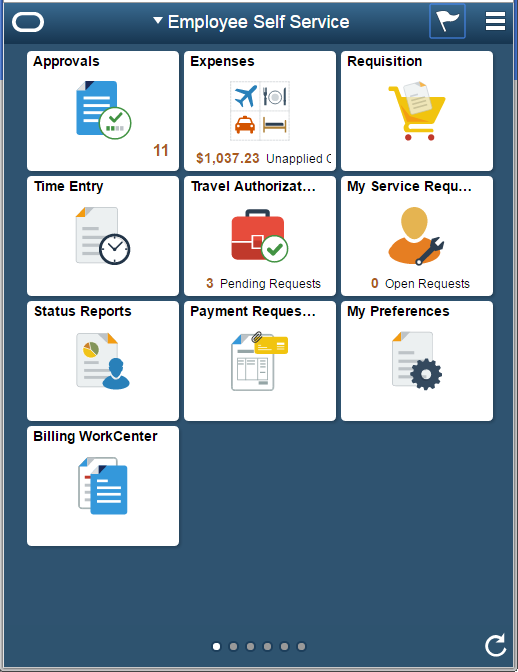
Expenses Tile
The Expense tile in the Employee Self-Service home page alerts you with the total amount of expenses in your wallet that still needs to be included in the expense report.
The amount displayed is for the employee ID that is linked to the login ID. If a user has access to multiple employees expenses, this amount will not include the amount from other employees.
This example illustrates the fields and controls on the Expenses Tile as displayed on a smartphone.
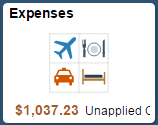
Common Elements Used with PeopleSoft Fluid User Interface
Field or Control |
Description |
|---|---|
|
Select to see a list of available actions for the current window. Access pages to personalize window content or sign out. |
|
Select to return to the main PeopleSoft Home page. |
|
Select to expand the NavBar window, where you can select window content from options, such as Recent Places, My Favorites, Navigator, My Preferences, and Fluid Home. Select again to collapse the NavBar window. |
|
Select to view actions and alerts in a notifications window. |
|
Select to access the personalization window, where you can add and remove selected tiles from the NavBar. |
|
Select to enter a global search. |
Use the Expenses Homepage (PT_LANDINGPAGE) to view notifications and navigate to various PeopleSoft Expenses processes.
Navigation:
. Select the Expenses tile.
This example illustrates the fields and controls on the Expenses Homepage as displayed on a smartphone. You can find definitions for the fields and controls later on this page.
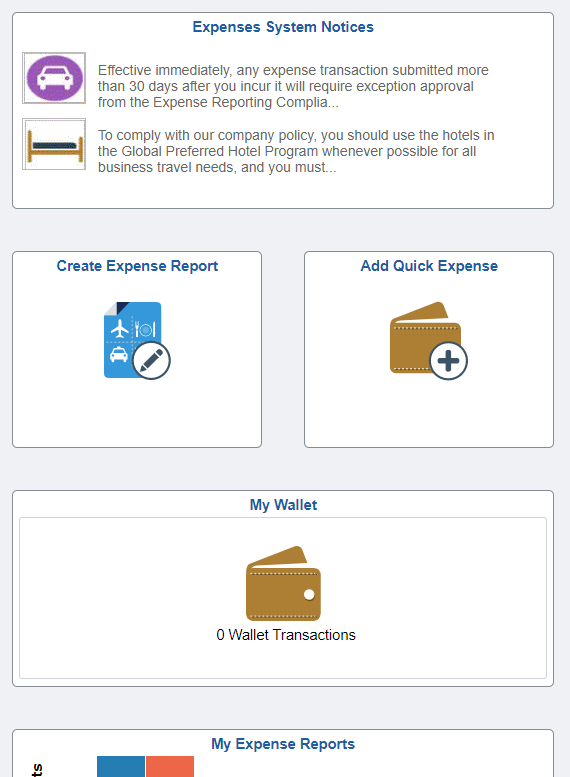
The Expenses homepage discusses how to:
View Notices
Add Quick Expense ( My Wallet)
Review and update My Wallet transactions
Create expense report
View and update active expense reports
Review expense history (Expense Reports and My Wallet)
Use the Expenses System Notices tile to view notices on the Fluid Expenses homepage.
Navigation:
This example illustrates the fields and controls on the Expenses System Notices Tile.
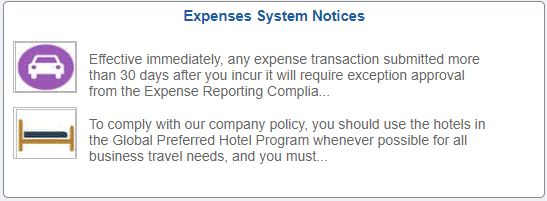
The Expenses System Notices tile displays the latest announcements from your travel and expenses department. Select the tile to view the Notices page.
Use the Notices page (EX_MBL_NOTICE_FL) to review the complete list of the announcements.
Navigation:
This example illustrates the fields and controls on the Notices page as displayed on a tablet. You can find definitions for the fields and controls later on this page.
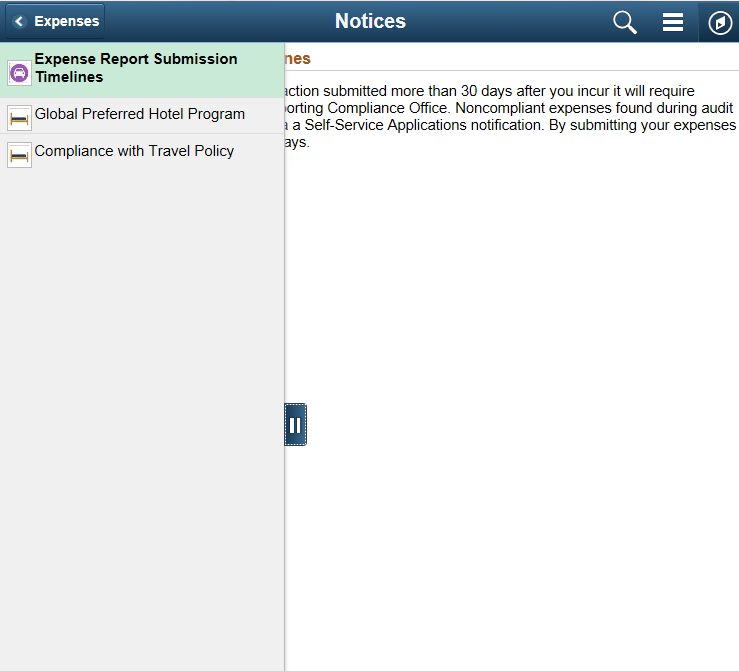
This example illustrates the fields and controls on the Notices page as displayed on a smartphone. You can find definitions for the fields and controls later on this page.
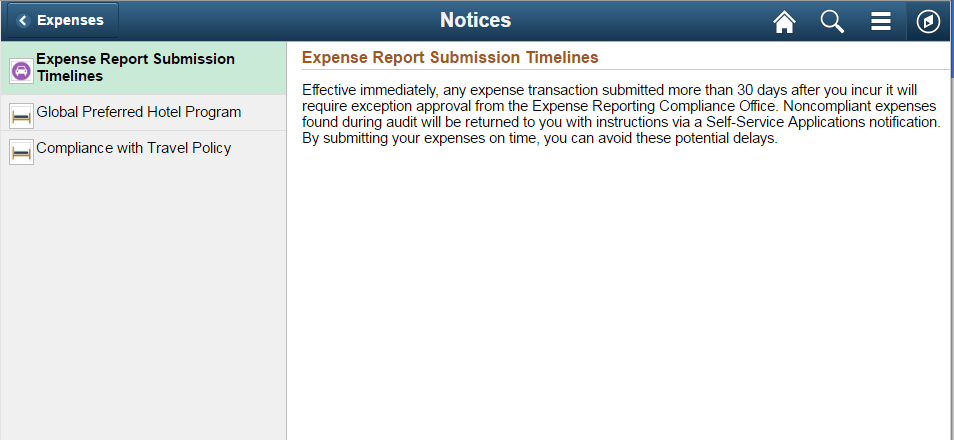
The data displays in a two-panel format. The summary of the notices are listed on the left panel, and the right panel displays the details based on the notice title you select on the left panel.
Note: You can add or modify notices using the PeopleSoft Classic User Interface. For more information, see Notices/Announcements Page
Use the Add Quick Expense tile from the Expenses homepage to create a new wallet transaction.
Navigation:
.
This example illustrates the fields and controls on the Add Quick Expense Tile.
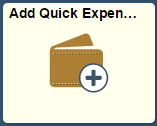
Select the Add Quick Expense tile to view the My Wallet page.
Use the My Wallet page (EX_TRANS_LN_FL) to record a cash or incidental expenses to your wallet so that you can add them to an expense report at a later time.
Navigation:
.
This example illustrates the fields and controls on the My Wallet page as displayed on a smartphone. You can find definitions for the fields and controls later on this page.
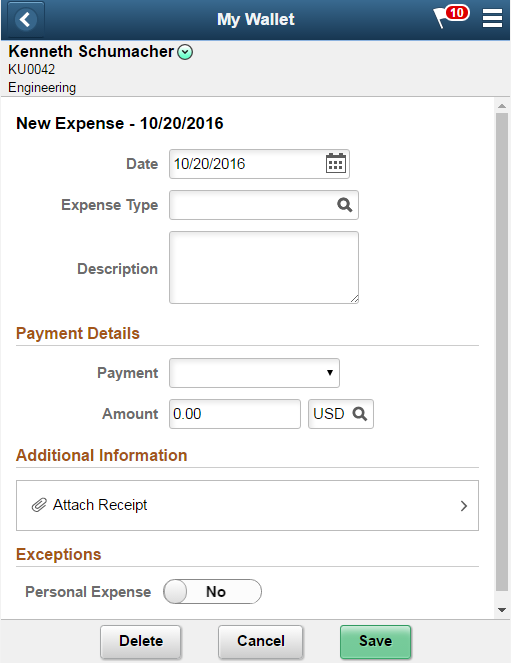
Note: Additional fields are dynamically displayed on this page based on required fields that are designated for the particular expense type on the Expense Types setup pages (EX_EXPENSE_TYPES1). For example, when you select Air Travel, the Ticket Number and Merchant fields appear (some exceptions apply). For more information, see Expense Types 1 Page
For more information on My Wallet transactions, see Understanding My Wallet Transactions.
Field or Control |
Description |
|---|---|
Date |
Displays the transaction date. The current date is the default value. |
Expense Type |
Select an expense type to add an expense item. The system displays the additional fields associated with the expense type after this field is selected. For more information, see the section Selecting Expense Types using PeopleSoft Fluid in Expense Entry Page On selecting the expense type, the user default values will be populated based on the user profile set up for the employee in the Employee Profile - User Defaults page. |
Originating Location and Destination Location |
If you select Expense Type as Automobile Mileage, then you must enter the originating and destination locations. In the Originating Location field, select the location (which you establish during system setup) from where you began your business travel. PeopleSoft Expenses prepopulates this field if you enter an originating location on the Employee Profile - User Defaults page. When you import this wallet, these fields Originating Location and Destination Location will also be imported into the expense report. |
Description |
Enter free text in this field. |
Payment Details |
Select a payment method. If the payment is made using a card, enter the card details. If you submit expenses in foreign currency, the system automatically display the currency exchange rate and converts the currency to the employee’s base currency. You can override the system-supplied exchange rate. Use the Reset Exchange Rate icon to change the overridden exchange rate to the system-defined exchange rate. |
Attach Receipt |
Upload existing file or capture receipt image for the expense. For more information, see Attaching Receipts in PeopleSoft Fluid You can upload multiple files at a time depending on configured attachment upload limit. To configure attachment upload limit, see Installation Options - Multiple Attachments Page. |
Merchant |
Indicates the transaction supplier. This field displays only if Merchant is selected as required fields for the expense type selected. See Setting Up Expense Types If a non-preferred merchant is selected, you must provide a justification for not using the company’s selected preferred merchant. |
Expense Location or Originating Location |
Select the location where you incurred the expense. This field is displayed if Location or Originating Location is selected as required fields for the expense type selected. See Setting Up Expense Types |
Personal Expense |
Select to indicate that the transaction is a non-reimbursable expense. If the transaction is from a manually entered expense and the expense type is defined as non-reimbursable, then the Personal Expense option is set to yes and cannot be changed. If the transaction was loaded into the system using a credit card feed process and the expense type is defined as a non-reimbursable expense, then the Personal Expense option is set to yes and cannot be changed. Rules for the Personal Expense selection:
For example: A user selects an enhanced data row as personal expense. This row was not non-reimbursable from the credit card feed. If they add it to an expense report and delete it, upon return to My Wallet, the value will still be personal expense. It will not revert to the original credit card feed value. |
Receipt Breakdown |
Displays the detail or summary data that is imported from credit card suppliers for the Hotel/Lodging expense type. The level of data (detail or summary) is determined by the Credit Card Import Hierarchy option on the Credit Card –Supplier page and the agreement that the hotel supplier has with the credit card supplier. This section is hidden if there is no data. |
This example illustrates the fields and controls on the Receipt Breakdown section as displayed on a tablet. You can find definitions for the fields and controls later on this page.
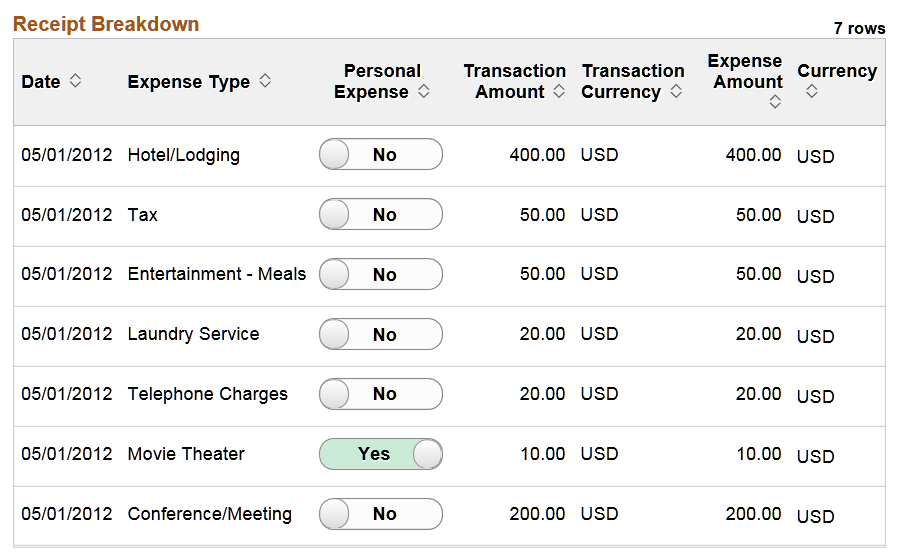
This example illustrates the fields and controls on the My Wallet page as displayed on a tablet.
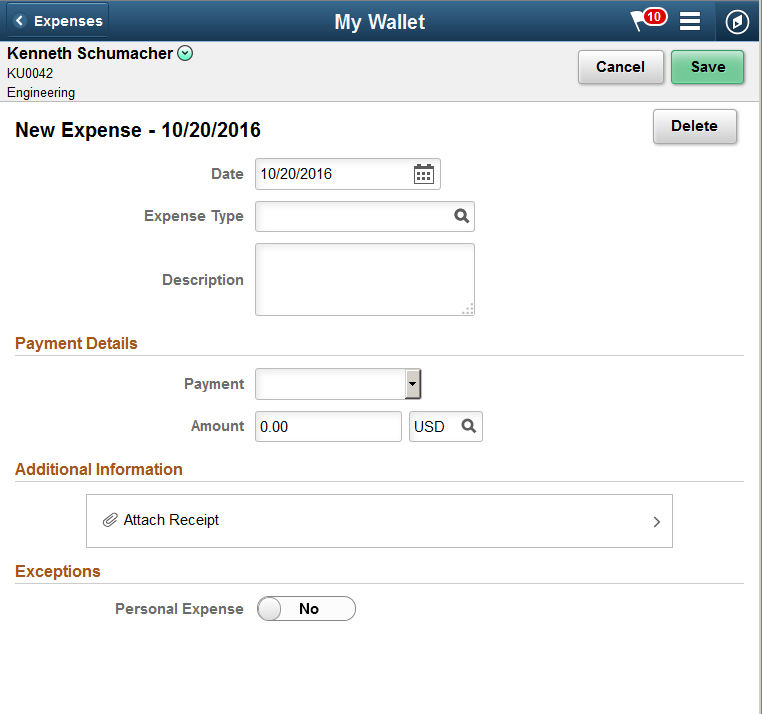
On a tablet or a desktop, when you select the Add Quick Expense tile, a new expense line displays on the left panel. When you complete your entry and select Save, the left panel updates the new expense line with the entered expense type.
Creating Wallet for Other Employees
Use the Employee Search page (EX_EMPL_SRCH_SCF) to create wallet entries for other employees.
Navigation:
.
Select Change Employee from the Action menu in the header.
This example illustrates the fields and controls on the Employee Search page.
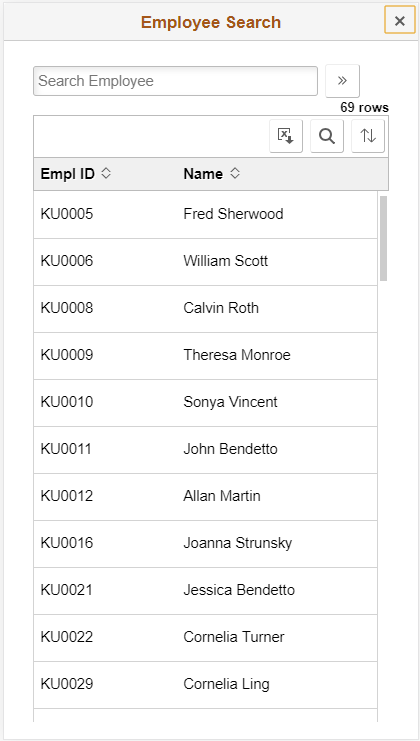
The Employee Search grid displays the list of employees for whom the current user has the Edit or Edit/Submit access to create a wallet. For more information on setting up authorized users to process expense transactions for themselves and for others, see Setting Up Authorized Users
Select an employee for whom you want to create a wallet. You can also use the search box to enter employee name, stream line your search, and select an employee.
Use the My Wallet tile from the Expenses homepage to review and edit My Wallet transactions.
Navigation:
This example illustrates the fields and controls on the My Wallet Tile.
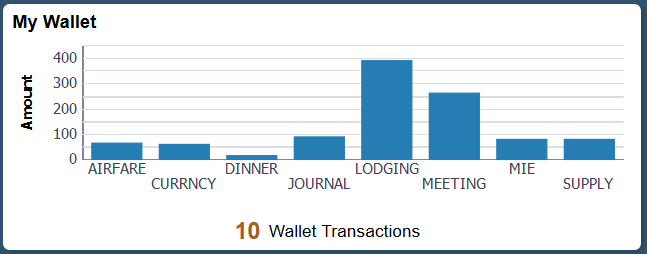
The graphical information will shows the top 7 expense types in your wallet. If you are using larger device such as tablet or desktop, the tile will display the top 10 expense types. At the bottom of the tile will display the number of expenses stored in your wallet.
The data displayed is for the employee ID that is linked to the login id. If a user has access to multiple employees expenses, this amount will not include the amount from other employees. Only My Wallet entries that have not been assigned to expense report will be included.
The My Wallet Dashboard will display with the tile indicated ‘0 Wallet Transactions’ if you do not have unassigned wallet transactions. However, you will still be able to select the tile.
Select the My Wallet tile to view the My Wallet page.
Use the My Wallet page (EX_TRANS_LN_FL) to view a list of all outstanding wallet entries that have not yet been imported into an expense report for reimbursement. Transactions can come from credit card data feeds and the Add Quick Expense in Fluid Expenses. The amount is displayed in the base currency of the employee’s business unit.
You may save the Wallet even without entering any data. You can fill in the fields later, or fill in the fields when you import the wallet entry to the expense report.
Navigation:
This example illustrates the fields and controls on the My Wallet page as displayed on a smartphone. You can find definitions for the fields and controls later on this page.
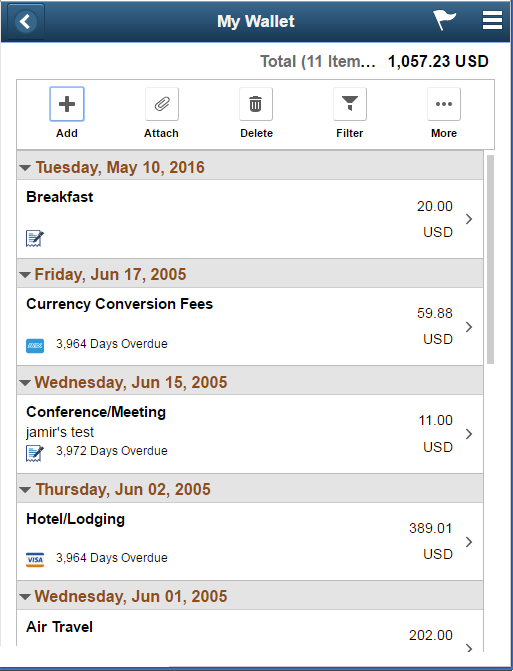
Field or Control |
Description |
|---|---|
|
Add a new wallet entry manually. See Add Quick Expense Tile |
|
Select to attach receipts. You can upload multiple files at a time depending on configured attachment upload limit. To configure attachment upload limit, see Installation Options - Multiple Attachments Page. The Attach button turns green which indicates that you are in the attachment mode for uploading receipt file. Select the wallet entry on which you want to add the receipt image. To return to normal mode, select the Attach button again. For more information, see the section Attaching Receipts using PeopleSoft Fluid in Expense Entry Page. |
|
Select the Delete button to delete a single wallet entry. Select a wallet entry from the list to delete. On mobile device such as smartphone, the Attach button turns green that indicates that you are in the delete mode. Select a wallet entry from the list to delete. To return to normal mode, select the Delete button again. On tablet or desktop, the Delete button will delete the wallet entry displayed on the left panel. |
|
Filter the data to narrow down the wallet transactions you want to see. This Filter button will be displayed in green to indicate there is filter criteria being entered. |
|
Select the More button to open additional action buttons. To return to previous action options, select the More button again. |
|
Use Select All or Deselect All button to select or deselect wallet entries that are displayed on the page. You can also use the check box next to wallet or click on the wallet row to select one wallet item at a time. |
|
Export the selected wallet transactions into a new expense report. To export into an existing expense report, use the Wallet Import function in Expense Details page. |
|
Delete multiple wallet entries at the same time. Select the wallet entries you want to delete, and then select the Delete button. |
Days Overdue |
Displays the number of days that the credit card transaction is overdue, based on the business unit definition for the Credit Card Data Overdue field. |
Data Source |
Indicates the source of the data such as manual entry, Visa or Amex. |
|
Indicates that receipt image has been uploaded into the system. |
|
Indicates the wallet entry has Report breakdown or enhanced data. |
Use the Create Expense Report tile to either create a new expense report , add expenses manually or import from wallet.
Navigation:
This example illustrates the fields and controls on the Create Expense Report Tile.
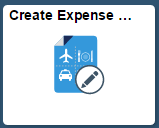
For more information on creating a new expense report, see Creating and Modifying Expense Reports Using PeopleSoft Fluid
For information on importing from wallet, see Importing My Wallet Data into an Expense Report using PeopleSoft Fluid
Use the My Expense Reports tile from the Expenses homepage to view all the active expense reports.
Navigation:
This example illustrates the fields and controls on the My Expense Reports Tile as displayed on a smartphone. You can find definitions for the fields and controls later on this page.
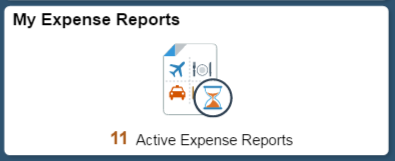
This example illustrates the fields and controls on the My Expense Reports Tile as displayed on a tablet. You can find definitions for the fields and controls later on this page.
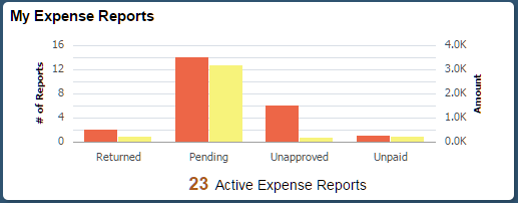
The My Expense Report tile displays the total number of expenses that have not been submitted, approved or paid. If you are using a larger device, the Expenses Application will display the graphical view of the expense amount and the number of expenses in each status.
The data displayed is for the employee ID that is linked to the login id. Select the My Expense Report tile to view the My Expense Reports page.
Use the My Expense Reports page (EX_EXP_LIST_FL) to review all of your expenses in various statuses including returned by approver or auditor, not submitted, submitted and waiting for approval or approved and pending for payment.
This example illustrates the fields and controls on the My Expense Reports as displayed on a smartphone. You can find definitions for the fields and controls later on this page.
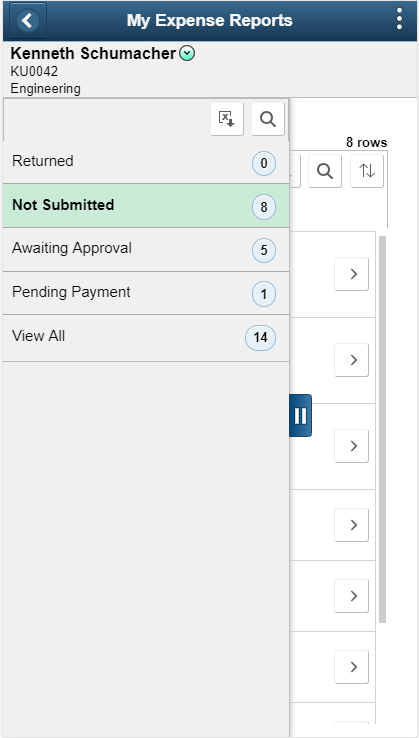
The data displays in a two-panel format. The left panel displays the expense report categories and the report-count for each category.
The right panel displays the expense reports based on the expense category you select on the left panel. The number bubble next to each status indicates the number of expense report in that status. The status that is highlighted in green is the status that is currently being selected.
On the right panel, select an expense report and drill down to My Expense Reports page. From this page, you can easily find the status of your expense report and who is the next in line to approve your report.
Field or Control |
Description |
|---|---|
Create Expense Report |
Select to create a new expense report. For more information, see Expense Report Page |
|
Narrow down the expense report list. This Filter button will be displayed in green to indicate there is filter criteria being entered. |
|
Sort the data within My Expense Reports list. The Sort button is displayed in green to indicate specific sort criteria that is being used. |
|
Select an expense report to view or update the expense report. If the expense report selected is not submitted yet, the system will display the Expense Detail page. Otherwise, the system will display the Report Summary page. |
|
Select the slider to show the left panel of My Expense Reports. |
On devices such as a tablet or a desktop, you may view the pages in the two-panel layout. The list of the expense reports are displayed in the grid format.
This example illustrates the fields and controls on the My Expense Reports page. You can find definitions for the fields and controls later on this page.
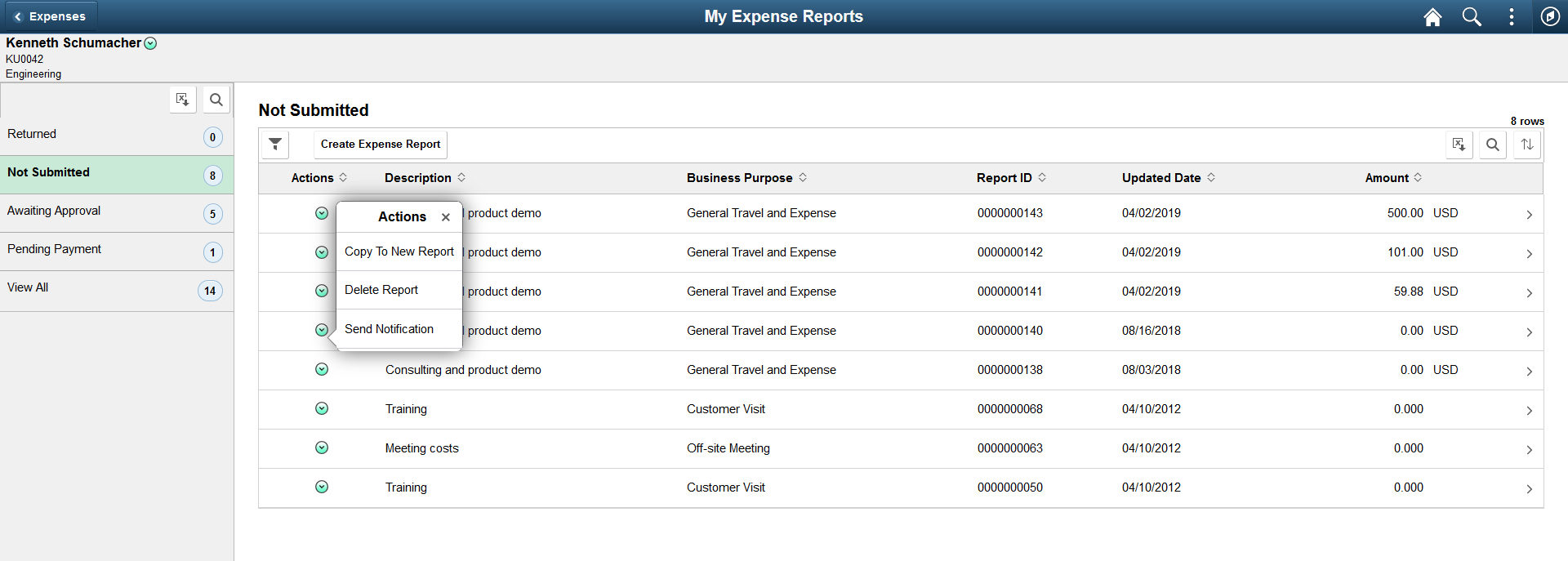
Note: The data display on the left panel may different based on the Expense Report status. For example, the Approver Role and Approver Name are available on the expense report list in Awaiting Approval status. The type of device and the available screen space will also derive the information being displayed. For example, on smartphone, report Description and Business Purpose will not be displayed.
The following options are available to you when you view the My Expense Reports.
Field or Control |
Description |
|---|---|
Copy To New Report |
Copy the existing report to a new expense report. |
Delete Report |
Delete an Expense Report that is in pending status. This button is available only if the expense report status is Not Submitted or Returned by Approver. |
Send Notification |
Select to access the Send Email Page to send a notification to the approver or other people. |
|
Select to download the search results to Microsoft Excel spreadsheet. |
|
Select to find a string in the current page. |
|
Select to sort the data within the Search Results grid. |
Viewing Expense Reports of Other Employees
Use the Employee Search page (EX_EMPL_SRCH_SCF) to view expense reports created by other employees.
Navigation:
.
Select Change Employee from the Action menu in the header.
This example illustrates the fields and controls on the Employee Search page.

The Employee Search grid displays the list of employees for whom the current user has the Edit or Edit/Submit access to view expense reports. For more information on setting up authorized users to process expense transactions for themselves and for others, see Setting Up Authorized Users
Select an employee for whom you want to view the expense report. You can also use the search box to enter employee name, stream line your search, and select an employee. The My Expense Report page displays all the data for the employee you have selected.
Note: When you create an expense report from the My Expense Reports page, the expense report will be created for the employee you have selected and not for the employee linked to the login ID.
Use the Expense History tile from the Expenses homepage to display the history data for expense reports and My Wallet transactions.
Navigation:
This example illustrates the fields and controls on the Expense Report History Page as displayed on a smartphone. You can find definitions for the fields and controls later on this page.
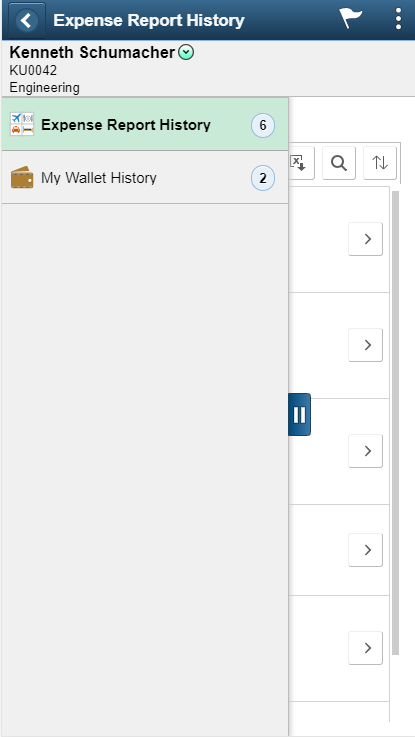
The data displays in a two-panel format. The left panel displays the expense history categories and the report-count for each category. The right panel displays the expense history based on the expense category you select on the left panel.
On the right panel, select an expense history or a wallet history.
Expense Report History Page
Use the Expense Report History page (EX_RPT_HIST_FL) to view the expense reports that are completed in the last 6 months. By default, the system will display the last 6 months of your data and you can adjusted it using My Preference page. For more information, see the section My Preferences Page in this document.
Navigation:
Select Expense Report History.
This example illustrates the fields and controls on the Expense Report History page as displayed on a smartphone. You can find definitions for the fields and controls later on this page.
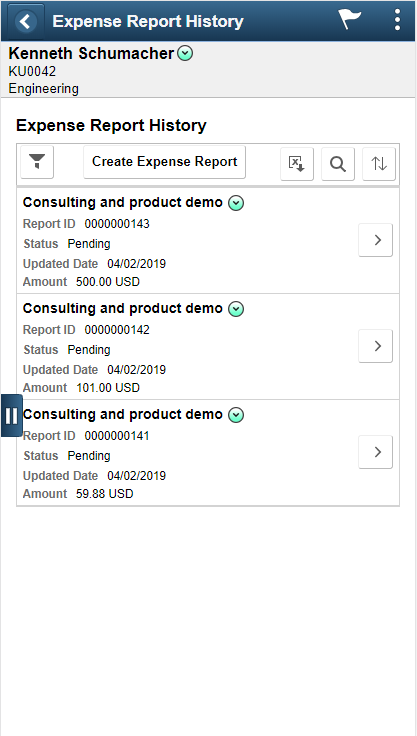
Note: Expense History displays on larger device such as iPad, tablet or desktop will be displayed in grid format. It may contain additional data such as report description and business purpose that are not displayed on smartphone.
Field or Control |
Description |
|---|---|
|
Select to change the date range if no reports are displayed based on the search criteria entered in My Preferences page. For information, see the section My Preferences page in this document. This Update Filter button displays if you tried to filter the data and there is no data returned. This filter button will be displayed in green to indicate there is filter criteria being entered. |
Create Expense Report |
Select Create Expense Report to create a new expense report. For more information, see Expense Report Page |
|
Select to download the expense reports to Microsoft Excel spreadsheet. |
|
Select to find a string in the current page. |
|
Sort the data within the expense history list. The Sort button is displayed in green to indicate specific sort criteria that is being used. |
|
Select an expense report or view the expense report. If the expense report selected is not submitted yet, the system will display the Expense Detail page. Otherwise, the system will display the Report Summary page. |
|
Select the slider to show the left panel of expense history. |
Viewing Expense History of Other Employees
Use the Employee Search page (EX_EMPL_SRCH_SCF) to view Expense History of other employees.
Navigation:
.
Select Change Employee from the Action menu in the header.
This example illustrates the fields and controls on the Employee Search page.

The Employee Search grid displays the list of employees for whom the current user has the Edit or Edit/Submit access to view expense history. For more information on setting up authorized users to process expense transactions for themselves and for others, see Setting Up Authorized Users
Select an employee for whom you want to view the expense history . You can also use the search box to enter employee name, stream line your search, and select an employee. The Expense Report History page displays all the data for the employee you have selected.
Note: When you create an expense report from the Expense Report History page, the expense report will be created for the employee you have selected and not for the employee linked to the login ID.
Related Actions in Expense Report History
Within the Expense Report History, you can perform the following actions:
Field or Control |
Description |
|---|---|
Copy Expense Report |
Copy the existing report to a new expense report. |
Send Notification |
Select to access the Send Email Page and send a notification. |
My Wallet History Page
Use My Wallet History page (EX_WALLET_HIST_FL) to the view list of expenses in your wallet that have been applied to expense report in the last 6 months. By default, the system will display the last 6 months of your data and you can adjusted it using My Preference page. For more information, see the section My Preferences Page in this document.
Navigation:
. Select My Wallet History
This example illustrates the fields and controls on the My Wallet History page. You can find definitions for the fields and controls later on this page.
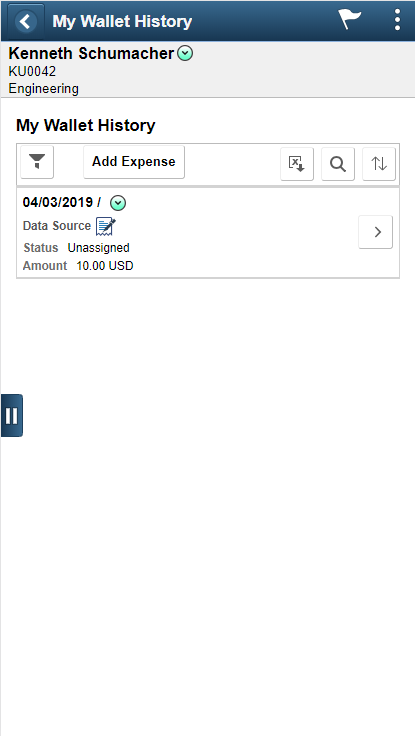
Field or Control |
Description |
|---|---|
|
Select to change the date range if no reports are displayed based on the search criteria entered in My Preferences page. For information, see the section My Preferences page in this document. This Update Filter button displays if you tried to filter the data and there is no data returned. This filter button will be displayed in green to indicate there is filter criteria being entered. |
Add Expense |
Select Add Expense to create a new wallet transaction. For more information, see Add Quick Expense Tile |
|
Sort the data within the expense history list. The Sort button will be displayed in green to indicate specific sort criteria that is being used. |
|
Select a wallet row or view My Wallet data. |
|
Select the slider to show the left panel of expense history. |
Related Actions in My Wallet History
Within the My Wallet History, you can perform the following actions:
Field or Control |
Description |
|---|---|
View Expense Report |
View the expense report. This option is available only if the wallet entry is assigned to an expense report. |
Send Notification |
Select to access the Send Email Page and send a notification. |
Restore My Wallet |
Restore My Wallet receipts that were previously deleted. |
My Preferences Page
Use the My Preferences page (EX_MY_PREF_FL) to update the search criteria for the expense history. You have search options that you can set for My Wallet and Expense Reports.
Navigation:
Select My Preferences from the Actions List
This example illustrates the fields and controls on the My Preferences page as displayed on a smartphone.
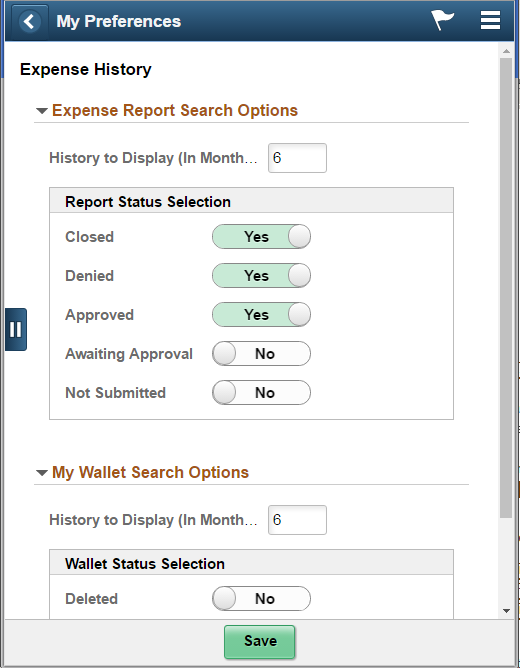
This example illustrates the fields and controls on the My Wallet Search Options. You can find definitions for the fields and controls later on this page.
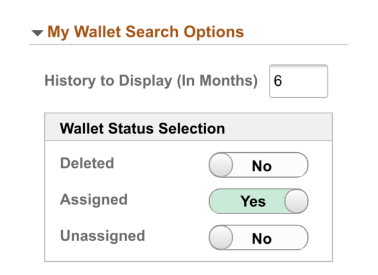
Enter the number of months you want to display the history data in the History Data to display field. By default, the system displays the last 6 months of your data.
Use the Status Selection switches to further refine your search criteria for the expense history.
Based on the preferences you set in the My Preferences page, the history data displays in the Expense History page.
 (Actions List)
(Actions List) (Home)
(Home) (NavBar)
(NavBar) (Notifications)
(Notifications) (Personalize NavBar)
(Personalize NavBar)
















